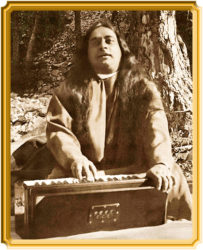
Durga Mata describes how Yogananda composed his Cosmic Chants:
“Master loved to have sankirtans with us all. He usually played the harmonium and led us in chanting. He played the large drum too. He could make that big drum really boom. His fingers would go like lightning on the tabla drums. He made the esraj talk. Master loved to demonstrate his ability of playing the different instruments. He certainly played them equally well and expressively. When he went into a deep meditation or samadhi, he usually came out with a new inspiring chant, giving vent in words to the depth of his perception.
Then he chanted that one over and over again, everyday, or during evening time, or on other occasions for months on end, as he said, ‘to spiritualize them,’ even though they were already spiritualized, for he had received the words from God.
When he chanted, one could feel the meaning he put behind the words, for he chanted with his heart and mind, not with just his voice.”
Here is one beautiful incident when he composed a Cosmic Chant:
“Master loved to go to the beach. One time we went to Dana Point, California, and parked on the cliff overlooking the sea. We remained there for several days. One afternoon the four of us – that is Master, Karla Schramm, Carson [the driver] and myself – were standing in a row looking out at the sea. While we were gazing out to sea, several rays of light slanting towards the ocean appeared in the sky. It was like sunrays piercing through the clouds. One of us mentioned it to Master. He rejoicingly said, ‘I am glad you are all seeing this miracle from God.’ It was this occasion that inspired Master to write and compose the chant, Come, Listen to My Soul Song.”
Here is another magical moment when a Cosmic Chant was born:
“Another time we went to Palm Springs. We parked the housecar at the Palm Canyon and camped there for several days. One day Master and we were walking in the canyon, he asked me to sing ‘Divine Love Sorrows.’ Seeing the century-old trees and rocks, I felt the deep meaning of Master’s words, ‘Centuries and centuries I called out for Thy name.’
Another time in that same canyon, Master washed his hair in the brook and sat on a large rock to meditate, while the warm sun dried his hair. He went into a very deep ecstasy. Karla was sitting on another rock a short distance from Master, and I was a good distance away on a huge rock meditating too.
He called us both to go back to the housecar. As I joined him and walked directly behind him, I was caught in a tremendous feeling of stillness. It was as though all motions of the body and, particularly, the mind had stopped and I was only conscious of that omnipresent stillness. I was conscious of walking and careful to avoid obstruction on the pathway. As we approached the housecar, Master turned and instructed me to pick up some firewood. I did so without losing that blissful feeling of stillness. I laid the wood down and followed Master into the housecar. He stopped on the step, and turning to face me said, ‘Stillness is God.’
This occasion also inspired Master to write and compose another chant, Come Out of the Silent Sky.”
A third example of how he composed a Cosmic Chant again comes from Durga Mata’s book, Trilogy of Divine Love:
“In the summer of 1929, Master was deeply hurt when Dhirananda, whom he loved so dearly, turned from love and struck out independently and finally left the religious life to marry. Master went to Mexico to forget and we thought he would never come back. But the Lord mended Master’s wounded heart. Then he composed the chant, My Lord I Will Be Thine Always.”
